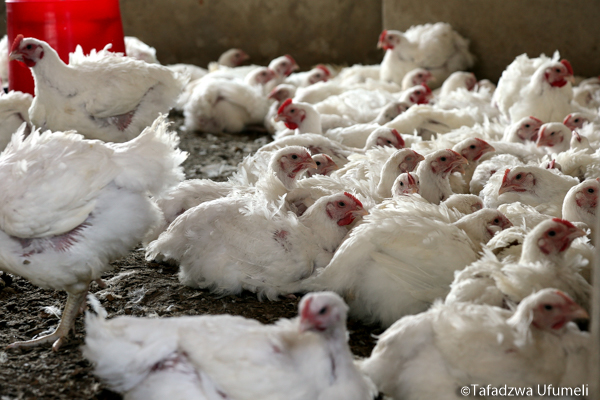
By Talent N Ndlovu
POULTRY production and its entire value chain constitute a significant part of the Zimbabwean agricultural industry and the economy at large. In recent years, demand for poultry products, primarily chicken and its products appear to have driven growth in the poultry industry, increasing not just the quantities produced but also the number of producers.
Importance of the poultry industry with the smallholder at the centre
The increased demand for poultry could be attributed to a number of factors, including poultry meat being a healthier, more affordable, and more accessible household option compared to its substitutes such as beef, pork, chevon, or mutton while the demand for poultry products such as eggs could be explained by their multiple uses in households and the food industry, for meals, in cooking, and in baking and confectionaries.
The poultry production sector has numerous backward and forward inter-linkages with other industries, so that growth in the poultry production sector has spurred growth in its supporting industries, leading to growth in the entire value chain. The growth in poultry production has increased the demand for inputs such as feed, chicks, medicines and equipment. Also, it has placed greater demand on the many supporting industries involved in the marketing, storage and transport of input and output products. At the centre of all this growth lies the farmer, who is involved in the primary production of poultry and its products.
As is characteristic of Zimbabwe’s farming sector, the poultry industry is dual in nature, consisting of both large and small-scale farmers. Small-scale producers, who constitute a significant proportion of up to 75% of poultry farmers, are key to the success of this industry. This article will discuss the status of the country’s small-scale poultry farmer in this COVID-19 era, highlighting the trends, challenges and opportunities in the poultry industry through the lens of a small-scale farmer.
Impacts of COVID-19 on the small-scale poultry farmer
While the industry seemed to be on an upward trajectory in recent years, the onset of the COVID-19 pandemic and its strict lockdown restrictions in 2020 brought unprecedented changes to the industry which negatively affected the small-scale farmer.
- Chamisa under fire over US$120K donation
- Mavhunga puts DeMbare into Chibuku quarterfinals
- Pension funds bet on Cabora Bassa oilfields
- Councils defy govt fire tender directive
Keep Reading
The input supply side
Firstly, the global lockdown disrupted imports of the most valuable component of poultry production, that is, poultry breeding stock, resulting in the shortage of good quality chicks on the market. Farmers, who purchase their chicks locally, were then forced to rely on the poor quality chicks available. The poor-quality chicks were cited as having high mortality rates and slower growth rates than previous breeds. This was a major setback to farmers, and meant that even before commencing production, the odds were against them. This was even more devastating for small-scale farmers who can only afford to produce small bird volumes.
Secondly, in response to the closure of other lines of business while agriculture remained an essential service, there was a large influx of new poultry producers, mostly small-scale, that joined the industry. The influx placed a greater demand on the already challenged input provision sector. This not only led to disruptions in input supply — with farmers having to book almost two months in advance for their allocation of chicks, and sometimes feed was unavailable. Disruptions in input supply made planning difficult for the small-scale farmers, especially since they relied on ready-made feed and chicks which were sometimes out of stock. The input shortages coupled with an increased demand for inputs, may have ultimately led to an increase in input prices.
Increases in input prices
The curse of the smallholder poultry farmers lies firstly in the inability to generate their own inputs such as feed and chick inputs, forcing them to rely on ready-made products, and secondly being small, they have no power to negotiate or influence market prices, forcing them to take whatever input prices are prevailing. Over the past few years, the prices of feed and chicks have been increasing significantly. Small-scale farmers are left with no option but to absorb input price increases, leaving them even more vulnerable, less productive, and less profitable.
By increasing production costs and reducing profits, input price increases threaten the long-term sustainability of small-scale poultry production.
Although the factors driving the input price increases seem to be improving, the input price increases still seem to be prevailing. It has been cited that the improved harvests of soya and maize in 2021 would bring relief to poultry producers through reduced costs of feed. However, there appears to be no change to the small-scale farmers ordeal as prices of feed have continued to rise.
This suggests that the benefits of increased grain supply may only be immediately felt by poultry producers that make their own feed — large-scale producers, and may not have trickled down to the small-scale farmer who do not make their own feed. It is likely that it will take more than one good cropping season to stimulate a decrease in feed prices or possibly, to stabilise prices for the small-scale farmer that is at the end of the feed value chain. In terms of chick prices increases also seem to be prevailing even though the supply of chicks has now improved. It is yet to be seen when the improved chick supply will reduce or at the least stabilise chick prices in the long term.
Unfavourable output prices
Apart from being forced to bear increased production costs, being a price taker also forces the farmer to accept whatever output price for finished products prevails on the market. Small-scale farmers compete with large-scale farmers who have large livestock numbers, can influence both input production costs and output prices, and can afford lower output prices. With no influence on the market price and facing increased competition from large-scale producers, small-scale poultry producers are trapped in a cycle of low profitability and sustainability as they cannot raise the output prices in line with their production costs. Without any changes, the unfavourable market conditions may lead to small-scale farmers abandoning the poultry industry in favour of other more profitable enterprises.
Impact on markets and marketing
Thirdly, during the strict lockdown periods, many of the small businesses such as restaurants and food outlets who often purchased poultry products from small farmers were closed, shrinking the market. In addition, closure of businesses also reduced incomes for many household consumers, which reduced market demand. Small-scale farmers, already faced with high production costs, were then left with severely reduced incomes and profits since demand was also low. Although the lockdown has eased, most consumers are yet to recover fully in financial terms, hence, it may take a while for demand to recover and surpass pre-COVID-19 levels. This puts a strain on the long-term viability of poultry small-scale farmers.
Fourthly, the lockdown, especially the strict lockdowns made both the input and output markets become relatively difficult to access at one’s convenience. Consequently, the transaction costs of doing business increased for the small-scale farmer who now bear higher search costs as they faced many difficulties to attain inputs, services and to reach their market. However, overtime, as the lockdowns have become less stringent, it has become easier and less costly to do business and the transaction costs of doing business for the small-scale poultry farmer has gone down.
What can be done to improve the small-scale farmers situation?
The solution to small-scale farmers’ challenges in the poultry industry lies primarily in their ability to organise themselves collectively for some of their functions and in vertical integration.
The ancient words of wisdom that, there is power in numbers, could solve some of their challenges. If small-scale farmers organise themselves collectively to purchase inputs and to sell produce in groups, their negotiating power on the market would increase, hence giving them a chance to influence both input and produce prices. Farmers could also use collective action to organise marketing and transport activities, reducing production costs.
Another concept that could revolutionise small-scale poultry farming is use of collective action to vertically integrate additional functions such as feed manufacture. By manufacturing their own feed, farmers escape dependency on ready-made feed, and its associated prices that they have no power to control. Such an initiative can reduce production costs by large margins and make these farmers more competitive on the market.
Small-scale farmers could also use the power of collective action to create large, organised produce markets. By creating organised markets, small-scale farmers would become more visible, accessible, and able to provide large quantities, and a constant supply of produce. Large markets would certainly attract more buyers and increase small-scale farmers’ influence on produce prices.
Using the suggested collective action and vertical integration initiatives will certainly require large amounts of training, support and administration in order for them to work. It would therefore be advisable that farmer groups also include or hire the required personnel to make the initiatives successful.
Not all hope is lost
Small-scale poultry farmers have been hard-hit by numerous challenges driven by poultry industry’s negative response to the COVID-19 pandemic. The challenges, which include high input costs of feed and chicks, and shrunken markets, have lowered the profitability for the small-scale producers, threatening producers’ economic viability in the long term.
However, not all hope is lost as there are multiple initiatives that these farmers can take to regain their position on the market and increase profits. These initiatives include the use of collectiive action to organise markets, vertically integrate into feed production, and to purchase inputs, consequently increasing negotiating power and reducing individual farmer costs. With the right technical and administrative support, the suggested initiatives have the power to positively transform small-scale poultry farming, improving their viability and making them more sustainable.
- This article is republished from the African Thinker
- Talent Ndabenhle Ndlovu is a qualified Agricultural Economist. She holds a Master’s degree in Agricultural Science from the University of Pretoria.











